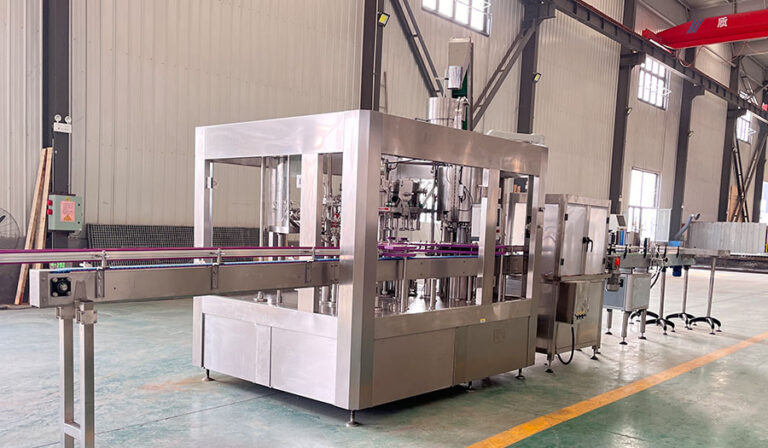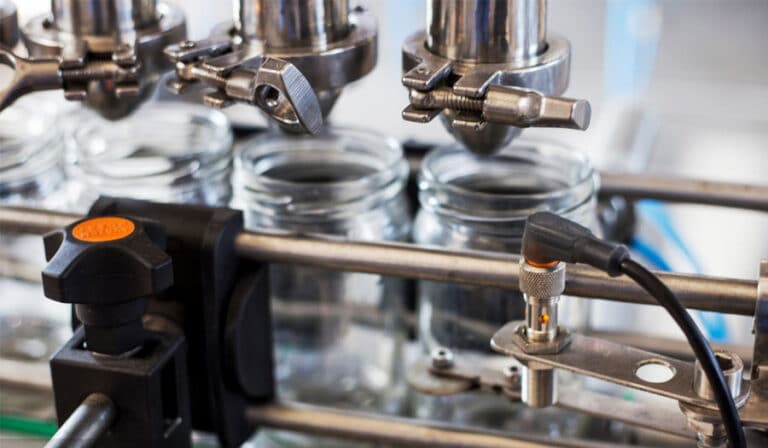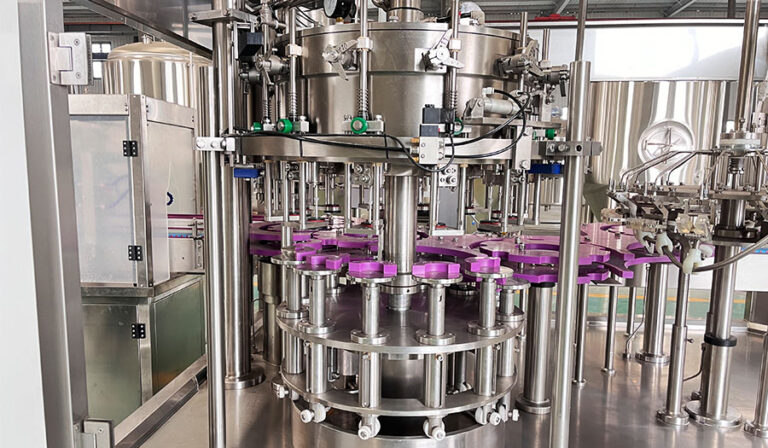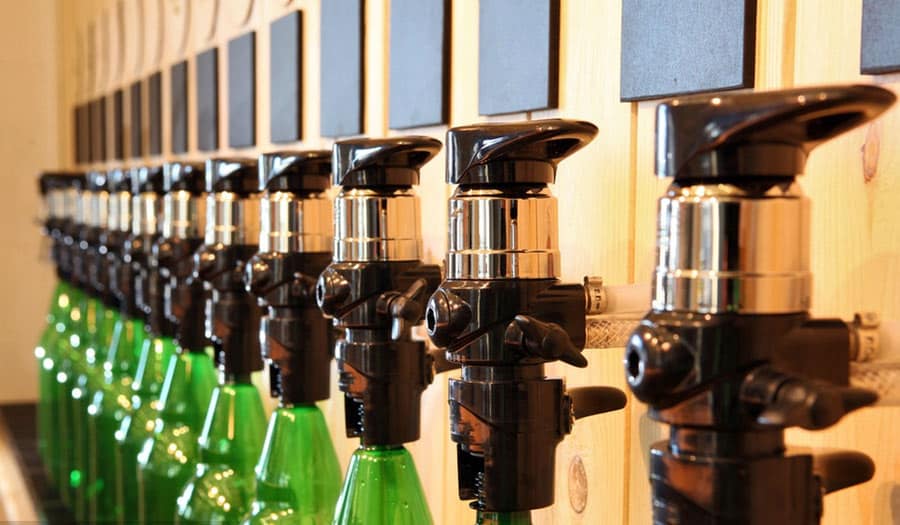A beer-filling machine is a machine used to fill beer into bottles or cans. It is commonly used in the beverage industry to bottle and can beer. The machine usually consists of several components, including a filling valve, a capping device, and a conveying system. In batch production equipment, the beer-filling machine, as a key link in the beer production line, plays an irreplaceable role. It not only undertakes the task of filling beer from storage tanks into bottles, cans, and other barrel packaging containers, but is also directly related to the quality of beer, production efficiency, and the enterprise’s competitiveness.
O que é uma máquina de enchimento de cerveja?
Beer filling machines are equipment used to fill beer into various containers such as bottles, cans, barrels, etc. Its main purpose is to fill beer safely, efficiently, and accurately into packaging containers for easy transportation and sales. With the process expansion of the beer market and the continuous improvement of consumers’ requirements for beer quality.
Filling machines are used to fill products into bags, pouches, or containers such as barrels or bottles. At the end of the production process, most commodities are measured in specified quantities and then put into bags or containers, and then sold on the market. There are many types of filling machines for liquids, pastes, powders, or granular materials.

How does the beer filling machine work?
The working principle of beer-filling machines can be divided into many types according to their filling methods, the most common of which are gravity filling, pressure filling, and vacuum filling transparent methods. While the specifics of how they work vary so much, most modern beer-filling machines employ automated control systems and precise liquid levels.
- Container preparation: Before filling, the beer filling machine first cleans and sterilizes the bottles or cans, focusing on the hygiene and safety of the containers. This process is usually achieved by spraying or soaking.
- Filling: After cleaning, the container is sent to the filling area, and the filling starts after the filling head is tightly connected to the container’s mouth. Factors such as temperature and pressure will affect the filling process, so the filling machine needs to have the ability to adjust these parameters. The filling process should be as short as possible to reduce oxygen infiltration.
- Sealing: After the filling is completed, the filling machine needs to be sealed to prevent the beer from being contaminated during transportation and storage. The sealing method can be a screw cap, pressure cap or aluminum foil seal, etc. The specific choice depends on the type of beer and market demand.
- Testing: Finally, the filling machine performs quality testing on the filled beer, including liquid level monitoring, sealing inspection, etc., to ensure the product qualification rate.
Types of Beer Filling Machines
Small Beer Filling Machines (2000-4000BPH)
Small beer bottle-filling machines are designed for breweries with lower production volumes but still require a high level of automation and efficiency. These automatic beer-filling machines increase production volumes compared to manual or semi-automatic beer-bottling machines.
Features of small beer-filling machines include:
- Automatic bottle supply station
- Automatic rinsing, filling, and capping processes
- Medium capacity (2000-4000 bottles/hour)
- User-friendly control system with a touchscreen
- Integrated with conveyor for smooth bottle delivery
- Adjustable settings to accommodate a variety of bottle sizes and types
- Optional features such as label application and data encoding
Medium beer-filling machines (6000-10000BPH)
Medium beer-filling machines are suitable for breweries with moderate production volumes that require higher production volumes and efficiency. These automatic beer-filling machines feature enhanced automation and advanced features.
Key features of medium-sized beer-filling machines include:
- Semi-automatic depalletizing system
- Automatic rinsing, filling, and capping processes
- Higher production capacity (6000-10000BPH)
- Advanced PLC control system
- Integration with labeling, date coding, and packaging systems
- High-speed operation with minimal downtime and changeover time
Large beer-filling machines (15000-18000BPH)
Large beer bottle-filling machines are designed for high-volume breweries that require the highest automation, speed, and efficiency. These automatic beer-filling machines offer best-in-class features and functionality.
Features of large beer-filling machines include:
- Automatic depalletizing system
- Automatic rinsing, filling, and capping processes
- High production capacity (15000-18000BPH)
- Advanced control system with programmable logic controller (PLC) and operator interface
- Integration with labeling, date coding, packaging systems, and palletizing systems
- High-speed changeover capabilities for different bottle sizes and types

Advantages and disadvantages of beer filling machines
|
TYPE OF EQUIPMENT |
ADVANTAGES |
DISADVANTAGES |
|
Manual Filling Machines |
Low upfront cost, easy to maintain, good for small batches. |
Slow, labor-intensive, not scalable. |
|
Semi-Automatic Machines |
Faster than manual, more accurate, moderate cost. |
Requires more space, needs some manual input. |
|
Automatic Filling Machines |
High-speed production, minimal labor, extremely precise. |
Expensive, complex to maintain, space-intensive. |
|
Counter Pressure Fillers |
Maintains carbonation, reduces beer loss. |
More complex to use, higher cost. |
|
Isobaric Fillers |
Ideal for cans and bottles, preserves beer quality. |
High price, requires trained staff. |
The function of beer filling machine
Melhorar a eficiência da produção
The beer-filling machine can significantly improve production efficiency. In the traditional manual filling stage, the production line speed is slow and limited by the efficiency of manual operations, making errors and waste prone to occur. After using the automated filling machine, the production speed has been greatly improved, and a large number of filling tasks can be completed in a short time, which greatly enhances the production capacity and meets the market’s growing demand for beer.
Garantir a qualidade do produto
The automated beer filling machine has high-precision control capabilities during the filling process, which can ensure that the filling volume of each bottle of beer is consistent and reduce errors caused by manual operation. In addition, filling machines generally use nitrogen filling or other technologies during the filling process to prevent the entry of oxygen, thereby effectively reducing the possibility of beer being oxidized and maintaining the freshness and flavor of beer.
Reduce production costs
While the upfront investment in a beer-filling machine may be higher, it can effectively reduce operating costs in the long run. With the improvement of automation, labor costs, and material waste have been significantly reduced. The efficient operation of the equipment makes the production process fast and smooth, thus improving the overall economic benefits.
Meet strict hygiene standards.
As a food, beer’s production process must comply with strict hygiene standards. Modern beer-filling machines are generally designed with effective cleaning and disinfection systems to ensure the hygiene and safety of the containers before filling. This is critical to safeguarding consumer health and corporate reputation.
Flexible adaptability
Different types of beer, different capacities, and types of containers are in demand in the market. Modern beer-filling machines are flexible in design, able to adapt to the filling needs of a variety of bottles and cans, and have strong market adaptability. This flexibility allows brewing companies to quickly respond to market changes and adjust production strategies.

How to choose a beer-filling machine?
- Production requirements: Choose the specifications of the filling machine according to the amount of beer produced daily. If the production scale is large, you need to choose a high-capacity filling machine; if it is a small brewery, you can choose small and medium-sized equipment.
- Container type: Determine the type of container to be filled (such as glass bottles, aluminum cans, plastic bottles, etc.). Different filling machines may only be suitable for specific types of containers. Some equipment may have the function of replacing filling heads to adapt to different types of containers.
- Degree of automation: According to the technical strength and staffing of the enterprise, choose equipment with the corresponding degree of automation. Fully automatic filling machines can reduce labor costs and improve efficiency; semi-automatic and manual equipment are suitable for start-ups or small-scale production.
- Filling method: Beer filling machines usually use different filling methods, such as gravity filling, vacuum filling, isobaric filling, etc. Choosing the right filling method can ensure the taste and quality of beer. Generally speaking, isobaric filling technology can reduce the oxidation of beer and maintain its freshness.
- Manufacturer reputation: Choosing a well-known equipment manufacturer can ensure equipment quality and after-sales service. It is very important to understand the after-sales service provided by the equipment manufacturer, including repair, maintenance, and technical support.
Conclusão
The beer-filling machine is an indispensable and important piece of equipment in modern beer production. It not only improves production efficiency and ensures product quality, but also reduces production costs and enhances the market competitiveness of enterprises. With the advancement of science and technology and changes in market demand, beer-filling machines will continue to develop in the direction of intelligence, environmental protection, and functionality, bringing new opportunities and challenges to the future beer industry.




